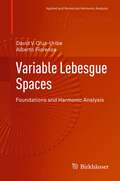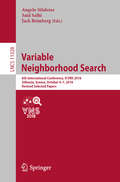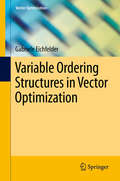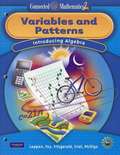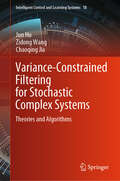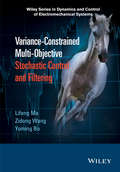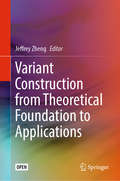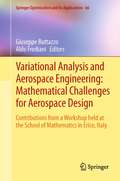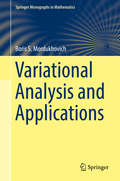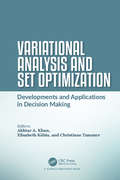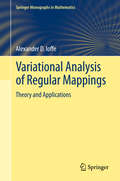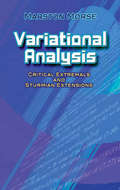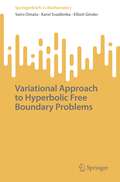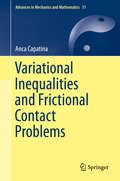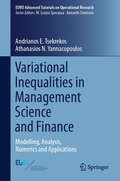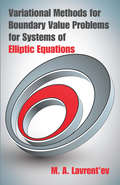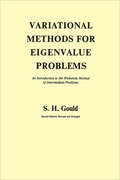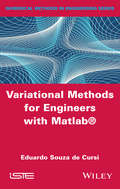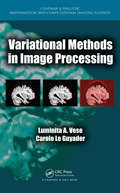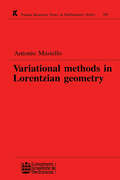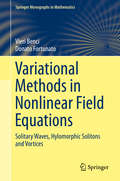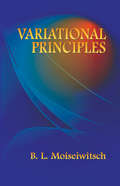- Table View
- List View
Variable Lebesgue Spaces
by Alberto Fiorenza David V. Cruz-UribeThis book provides an accessible introduction to the theory of variable Lebesgue spaces. These spaces generalize the classical Lebesgue spaces by replacing the constant exponent p with a variable exponent p(x). They were introduced in the early 1930s but have become the focus of renewed interest since the early 1990s because of their connection with the calculus of variations and partial differential equations with nonstandard growth conditions, and for their applications to problems in physics and image processing. The book begins with the development of the basic function space properties. It avoids a more abstract, functional analysis approach, instead emphasizing an hands-on approach that makes clear the similarities and differences between the variable and classical Lebesgue spaces. The subsequent chapters are devoted to harmonic analysis on variable Lebesgue spaces. The theory of the Hardy-Littlewood maximal operator is completely developed, and the connections between variable Lebesgue spaces and the weighted norm inequalities are introduced. The other important operators in harmonic analysis - singular integrals, Riesz potentials, and approximate identities - are treated using a powerful generalization of the Rubio de Francia theory of extrapolation from the theory of weighted norm inequalities. The final chapter applies the results from previous chapters to prove basic results about variable Sobolev spaces.
Variable Neighborhood Search: 6th International Conference, ICVNS 2018, Sithonia, Greece, October 4–7, 2018, Revised Selected Papers (Lecture Notes in Computer Science #11328)
by Said Salhi Angelo Sifaleras Jack BrimbergThis book constitutes the refereed post-conference proceedings of the 6th International Conference on Variable Neighborhood Search, ICVNS 2018, held in Sithonia, Greece, in October 2018. ICVNS 2018 received 49 submissions of which 23 full papers were carefully reviewed and selected. VNS is a metaheuristic based on systematic changes in the neighborhood structure within a search for solving optimization problems and related tasks. The main goal of ICVNS 2018 was to provide a stimulating environment in which researchers coming from various scientific fields could share and discuss their knowledge, expertise, and ideas related to the VNS metaheuristic and its applications.
Variable Ordering Structures in Vector Optimization
by Gabriele EichfelderThis book provides an introduction to vector optimization with variable ordering structures, i. e. , to optimization problems with a vector-valued objective function where the elements in the objective space are compared based on a variable ordering structure: instead of a partial ordering defined by a convex cone, we see a whole family of convex cones, one attached to each element of the objective space. The book starts by presenting several applications that have recently sparked new interest in these optimization problems, and goes on to discuss fundamentals and important results on a wide range of topics. The theory developed includes various optimality notions, linear and nonlinear scalarization functionals, optimality conditions of Fermat and Lagrange type, existence and duality results. The book closes with a collection of numerical approaches for solving these problems in practice.
Variables & Patterns: Focus on Algebra (Connected Mathematics #3)
by James T. Fey Susan N. Friel Elizabeth Difanis Phillips Patterns Focus on Algebra Glenda Lappan Connected Mathematics VariablesIn Variables and Patterns, you will study some basic ideas of algebra and learn some ways to use those ideas to solve problems and make decisions.
Variables and Patterns, Introducing Algebra
by Glenda Lappan James T. Fey William M. Fitzgerald Susan N. Friel Elizabeth Difanis PhillipsNIMAC-sourced textbook
Variables and Patterns: Introducing Algebra (Texas)
by Inc. Glenda Lappan James T. Fey William M. Fitzgerald Susan N. Friel Elizabeth Difanis Phillips WestWordsNIMAC-sourced textbook
Variance-Constrained Filtering for Stochastic Complex Systems: Theories and Algorithms (Intelligent Control and Learning Systems #18)
by Zidong Wang Jun Hu Chaoqing JiaThis book is concerned with the variance-constrained optimized filtering problems and their potential applications for nonlinear time-varying dynamical systems. The distinguished features of this book are highlighted as follows. (1) A unified framework is provided for handling the variance-constrained filtering problems of nonlinear time-varying dynamical systems with incomplete information. (2) The application potentials of variance-constrained optimized filtering in networked time-varying dynamical systems are outlined. It contains some new concepts, new models and new methodologies with practical significance in control engineering and signal processing. It is a collection of several research results and thereby serves as a useful reference for upper undergraduate, postgraduate and engineers who are interested in studying (i) the variance-constrained filtering, (ii) recent advances affected by incomplete information and (iii) potential applications in practical engineering systems.
Variance-Constrained Multi-Objective Stochastic Control and Filtering
by Zidong Wang Lifeng Ma Yuming BoUnifies existing and emerging concepts concerning multi-objective control and stochastic control with engineering-oriented phenomena Establishes a unified theoretical framework for control and filtering problems for a class of discrete-time nonlinear stochastic systems with consideration to performance Includes case studies of several nonlinear stochastic systems Investigates the phenomena of incomplete information, including missing/degraded measurements, actuator failures and sensor saturations Considers both time-invariant systems and time-varying systems Exploits newly developed techniques to handle the emerging mathematical and computational challenges
Variant Construction from Theoretical Foundation to Applications
by Jeffrey ZhengThis open access book presents theoretical framework and sample applications of variant construction. The first part includes the components variant logic, variant measurements, and variant maps, while the second part covers sample applications such as variation with functions, variant stream ciphers, quantum interference, classical/quantum random sequences, whole DNA sequences, and multiple-valued pulse sequences. Addressing topics ranging from logic and measuring foundation to typical applications and including various illustrated maps, it is a valuable guide for theoretical researchers in discrete mathematics; computing-, quantum- and communication scientists; big data engineers; as well as graduate and upper undergraduate students.
Variational Analysis and Aerospace Engineering: Mathematical Challenges for Aerospace Design
by Giuseppe Buttazzo Aldo FredianiThis volume consists of papers presented at the Variational Analysis and Aerospace Engineering Workshop II held in Erice, Italy in September 2010 at the International School of Mathematics "Guido Stampacchia". The workshop provided a platform for aerospace engineers and mathematicians (from universities, research centers and industry) to discuss the advanced problems requiring an extensive application of mathematics. The presentations were dedicated to the most advanced subjects in engineering and, in particular to computational fluid dynamics methods, introduction of new materials, optimization in aerodynamics, structural optimization, space missions, flight mechanics, control theory and optimization, variational methods and applications, etc. This book will capture the interest of researchers from both academia and industry.
Variational Analysis and Applications: Applications (A Series of Comprehensive Studies in Mathematics #331)
by Boris S. MordukhovichBuilding on fundamental results in variational analysis, this monograph presents new and recent developments in the field as well as selected applications. Accessible to a broad spectrum of potential readers, the main material is presented in finite-dimensional spaces. Infinite-dimensional developments are discussed at the end of each chapter with comprehensive commentaries which emphasize the essence of major results, track the genesis of ideas, provide historical comments, and illuminate challenging open questions and directions for future research. The first half of the book (Chapters 1–6) gives a systematic exposition of key concepts and facts, containing basic material as well as some recent and new developments. These first chapters are particularly accessible to masters/doctoral students taking courses in modern optimization, variational analysis, applied analysis, variational inequalities, and variational methods. The reader’s development of skills will be facilitated as they work through each, or a portion of, the multitude of exercises of varying levels. Additionally, the reader may find hints and references to more difficult exercises and are encouraged to receive further inspiration from the gems in chapter commentaries. Chapters 7–10 focus on recent results and applications of variational analysis to advanced problems in modern optimization theory, including its hierarchical and multiobjective aspects, as well as microeconomics, and related areas. It will be of great use to researchers and professionals in applied and behavioral sciences and engineering.
Variational Analysis and Set Optimization: Developments and Applications in Decision Making
by Akhtar A. Khan Christiane Tammer Elisabeth KöbisThis book contains the latest advances in variational analysis and set / vector optimization, including uncertain optimization, optimal control and bilevel optimization. Recent developments concerning scalarization techniques, necessary and sufficient optimality conditions and duality statements are given. New numerical methods for efficiently solving set optimization problems are provided. Moreover, applications in economics, finance and risk theory are discussed. Summary The objective of this book is to present advances in different areas of variational analysis and set optimization, especially uncertain optimization, optimal control and bilevel optimization. Uncertain optimization problems will be approached from both a stochastic as well as a robust point of view. This leads to different interpretations of the solutions, which widens the choices for a decision-maker given his preferences. Recent developments regarding linear and nonlinear scalarization techniques with solid and nonsolid ordering cones for solving set optimization problems are discussed in this book. These results are useful for deriving optimality conditions for set and vector optimization problems. Consequently, necessary and sufficient optimality conditions are presented within this book, both in terms of scalarization as well as generalized derivatives. Moreover, an overview of existing duality statements and new duality assertions is given. The book also addresses the field of variable domination structures in vector and set optimization. Including variable ordering cones is especially important in applications such as medical image registration with uncertainties. This book covers a wide range of applications of set optimization. These range from finance, investment, insurance, control theory, economics to risk theory. As uncertain multi-objective optimization, especially robust approaches, lead to set optimization, one main focus of this book is uncertain optimization. Important recent developments concerning numerical methods for solving set optimization problems sufficiently fast are main features of this book. These are illustrated by various examples as well as easy-to-follow-steps in order to facilitate the decision process for users. Simple techniques aimed at practitioners working in the fields of mathematical programming, finance and portfolio selection are presented. These will help in the decision-making process, as well as give an overview of nondominated solutions to choose from.
Variational Analysis of Regular Mappings
by Alexander D. IoffeThis monograph offers the first systematic account of (metric) regularity theory in variational analysis. It presents new developments alongside classical results and demonstrates the power of the theory through applications to various problems in analysis and optimization theory. The origins of metric regularity theory can be traced back to a series of fundamental ideas and results of nonlinear functional analysis and global analysis centered around problems of existence and stability of solutions of nonlinear equations. In variational analysis, regularity theory goes far beyond the classical setting and is also concerned with non-differentiable and multi-valued operators. The present volume explores all basic aspects of the theory, from the most general problems for mappings between metric spaces to those connected with fairly concrete and important classes of operators acting in Banach and finite dimensional spaces. Written by a leading expert in the field, the book covers new and powerful techniques, which have proven to be highly efficient even in classical settings, and outlines the theory's predominantly quantitative character, leading to a variety of new and unexpected applications. Variational Analysis of Regular Mappings is aimed at graduate students and researchers in nonlinear and functional analysis, especially those working in areas close to optimization and optimal control, and will be suitable to anyone interested in applying new concepts and ideas to operations research, control engineering and numerical analysis.
Variational Analysis: Critical Extremals and Sturmian Extensions
by Marston MorseThis text presents extended separation, comparison, and oscillation theorems that replace the classical analysis of Legendre, Jacobi, Hilbert, and others. Its analysis of related quadratic functionals shows how critical extremals can substitute for minimizing extremals.Author Marston Morse is renowned for his development of a version of variational theory with applications to equilibrium problems in mathematical physics--the theory known as Morse theory, which forms a vital role in global analysis. He begins this treatment of variational analysis with an extended investigation of critical extremals that proceeds to quadratic index forms, advanced and free. Additional topics include focal conditions and Sturm-like theorems, general boundary conditions, and prestructures for characteristic root theory. A helpful pair of appendixes include supplementary information on free linear conditions and subordinate quadratic forms and their complementary forms.
Variational Approach to Hyperbolic Free Boundary Problems (SpringerBriefs in Mathematics)
by Seiro Omata Karel Svadlenka Elliott GinderThis volume is devoted to the study of hyperbolic free boundary problems possessing variational structure. Such problems can be used to model, among others, oscillatory motion of a droplet on a surface or bouncing of an elastic body against a rigid obstacle. In the case of the droplet, for example, the membrane surrounding the fluid in general forms a positive contact angle with the obstacle, and therefore the second derivative is only a measure at the contact free boundary set. We will show how to derive the mathematical problem for a few physical systems starting from the action functional, discuss the mathematical theory, and introduce methods for its numerical solution. The mathematical theory and numerical methods depart from the classical approaches in that they are based on semi-discretization in time, which facilitates the application of the modern theory of calculus of variations.
Variational Inequalities and Frictional Contact Problems
by Anca CapatinaVariational Inequalities and Frictional Contact Problems contains a carefully selected collection of results on elliptic and evolutionary quasi-variational inequalities including existence, uniqueness, regularity, dual formulations, numerical approximations and error estimates ones. By using a wide range of methods and arguments, the results are presented in a constructive way, with clarity and well justified proofs. This approach makes the subjects accessible to mathematicians and applied mathematicians. Moreover, this part of the book can be used as an excellent background for the investigation of more general classes of variational inequalities. The abstract variational inequalities considered in this book cover the variational formulations of many static and quasi-static contact problems. Based on these abstract results, in the last part of the book, certain static and quasi-static frictional contact problems in elasticity are studied in an almost exhaustive way. The readers will find a systematic and unified exposition on classical, variational and dual formulations, existence, uniqueness and regularity results, finite element approximations and related optimal control problems. This part of the book is an update of the Signorini problem with nonlocal Coulomb friction, a problem little studied and with few results in the literature. Also, in the quasi-static case, a control problem governed by a bilateral contact problem is studied. Despite the theoretical nature of the presented results, the book provides a background for the numerical analysis of contact problems. The materials presented are accessible to both graduate/under graduate students and to researchers in applied mathematics, mechanics, and engineering. The obtained results have numerous applications in mechanics, engineering and geophysics. The book contains a good amount of original results which, in this unified form, cannot be found anywhere else.
Variational Inequalities in Management Science and Finance: Modelling, Analysis, Numerics and Applications (EURO Advanced Tutorials on Operational Research)
by Athanasios N. Yannacopoulos Andrianos E. TsekrekosThis book provides a rigorous introduction to the theory, computation, and applications of variational inequalities (VIs), with a focus on applications in management science and finance. It aims to bridge the gap between the abstract mathematical treatments of the subject and simplistic, non-rigorous approaches often used in financial economics or managerial literature. Building on fundamental examples of concrete applications drawn from management science and finance, the book gradually develops the connection between optimal stopping problems and variational inequalities. It provides precise results on their derivation, solution properties, and their use to derive optimal policies in general frameworks of stochastic factors driving the state processes. Emphasis is also placed on the numerical treatment and approximation of VIs. All technical results are illustrated in detail for the characteristic problems presented at the beginning as motivating examples. It also offers a brief introduction to more advanced topics, including VIs for multi-scale problems and VIs related to optimal stopping problems under model uncertainty. This book will be of interest to graduate students and researchers who wish for a quick, yet thorough introduction to the field. Practitioners who want to familiarise themselves with applications of VIs in management science and finance will also find this book useful.
Variational Methods for Boundary Value Problems for Systems of Elliptic Equations
by M. A. Lavrent’ev J.R.M. RadokIn this famous monograph, a distinguished mathematician presents an innovative approach to classical boundary value problems - one that may be used by mathematicians as well as by theoreticians in mechanics. The approach is based on a number of geometric properties of conformal and quasi-conformal mappings and employs the general basic scheme for solution of variational problems first suggested by Hilbert and developed by Tonnelli. The first two chapters cover variational principles of the theory of conformal mapping and behavior of a conformal transformation on the boundary. Chapters 3 and 4 explore hydrodynamic applications and quasiconformal mappings, and the final two chapters address linear systems and the simplest classes of non-linear systems. Mathematicians will take particular interest in the method of the proof of the existence and uniqueness theorems as well as the general theory of quasi-conformal mappings. Theoreticians in mechanics will find the approximate formulas for conformal and quasi-conformal
Variational Methods for Eigenvalue Problems: An Introduction to the Weinstein Method of Intermediate Problems (Second Edition) (Mathematical Expositions #10)
by S. H. GouldThe first edition of this book gave a systematic exposition of the Weinstein method of calculating lower bounds of eigenvalues by means of intermediate problems. From the reviews of this edition and from subsequent shorter expositions it has become clear that the method is of considerable interest to the mathematical world; this interest has increased greatly in recent years by the success of some mathematicians in simplifying and extending the numerical applications, particularly in quantum mechanics. Until now new developments have been available only in articles scattered throughout the literature: this second edition presents them systematically in the framework of the material contained in the first edition, which is retained in somewhat modified form.
Variational Methods for Engineers with Matlab
by Eduardo Souza de CursiThis book is issued from a 30 years' experience on the presentation of variational methods to successive generations of students and researchers in Engineering. It gives a comprehensive, pedagogical and engineer-oriented presentation of the foundations of variational methods and of their use in numerical problems of Engineering. Particular applications to linear and nonlinear systems of equations, differential equations, optimization and control are presented. MATLAB programs illustrate the implementation and make the book suitable as a textbook and for self-study. The evolution of knowledge, of the engineering studies and of the society in general has led to a change of focus from students and researchers. New generations of students and researchers do not have the same relations to mathematics as the previous ones. In the particular case of variational methods, the presentations used in the past are not adapted to the previous knowledge, the language and the centers of interest of the new generations. Since these methods remain a core knowledge - thus essential - in many fields (Physics, Engineering, Applied Mathematics, Economics, Image analysis . . . ), a new presentation is necessary in order to address variational methods to the actual context.
Variational Methods for Nonlocal Fractional Problems
by Giovanni Molica Bisci Vicentiu D. Radulescu Raffaella ServadeiThis book provides researchers and graduate students with a thorough introduction to the variational analysis of nonlinear problems described by nonlocal operators. The authors give a systematic treatment of the basic mathematical theory and constructive methods for these classes of nonlinear equations, plus their application to various processes arising in the applied sciences. The equations are examined from several viewpoints, with the calculus of variations as the unifying theme. Part I begins the book with some basic facts about fractional Sobolev spaces. Part II is dedicated to the analysis of fractional elliptic problems involving subcritical nonlinearities, via classical variational methods and other novel approaches. Finally, Part III contains a selection of recent results on critical fractional equations. A careful balance is struck between rigorous mathematics and physical applications, allowing readers to see how these diverse topics relate to other important areas, including topology, functional analysis, mathematical physics, and potential theory.
Variational Methods in Image Processing (Chapman & Hall/CRC Mathematical and Computational Imaging Sciences Series)
by Luminita A. Vese Carole Le GuyaderVariational Methods in Image Processing presents the principles, techniques, and applications of variational image processing. The text focuses on variational models, their corresponding Euler-Lagrange equations, and numerical implementations for image processing. It balances traditional computational models with more modern techniques that solve t
Variational Methods in Lorentzian Geometry (Chapman And Hall/crc Research Notes In Mathematics Ser. #309)
by Antonio MasielloAppliies variational methods and critical point theory on infinite dimenstional manifolds to some problems in Lorentzian geometry which have a variational nature, such as existence and multiplicity results on geodesics and relations between such geodesics and the topology of the manifold.
Variational Methods in Nonlinear Field Equations
by Vieri Benci Donato FortunatoThe book analyzes the existence of solitons, namely of finite energy solutions of field equations which exhibit stability properties. The book is divided in two parts. In the first part, the authors give an abstract definition of solitary wave and soliton and we develop an abstract existence theory for hylomorphic solitons, namely for those solitons which minimize the energy for a given charge. In the second part, the authors apply this theory to prove the existence of hylomorphic solitons for some classes of field equations (nonlinear Klein-Gordon-Maxwell equations, nonlinear Schrödinger-Maxwell equations, nonlinear beam equation,. . ). The abstract theory is sufficiently flexible to be applied to other situations, like the existence of vortices. The books is addressed to Mathematicians and Physicists.
Variational Principles (Dover Books on Mathematics)
by B. L. MoiseiwitschThis graduate-level text's primary objective is to demonstrate the expression of the equations of the various branches of mathematical physics in the succinct and elegant form of variational principles (and thereby illuminate their interrelationship). Its related intentions are to show how variational principles may be employed to determine the discrete eigenvalues for stationary state problems and to illustrate how to find the values of quantities (such as the phase shifts) that arise in the theory of scattering. Chapter-by-chapter treatment consists of analytical dynamics; optics, wave mechanics, and quantum mechanics; field equations; eigenvalue problems; and scattering theory. 1966 edition. Bibliography. Index.
